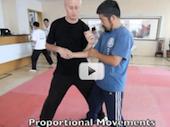Cloud hands correction … do not move fingers when starting the circle … Only the elbow comes in … Then before the hand can come out, a stretch has happen to open space under the armpit, then open up lower body, then push fingers out.
The wall exercise is good to do…Put your fingers on the wall as a reference, then practice bringing in elbow, shoulder & kua over as far as possible.
Note, the inside has to be big. Example … circle
We practiced closing the gap between ourselves and our opponent by first leading with the Kua, then closing other gaps until opponent was on the edge.
Basic internal stretching movements are important.
Practice drill: When the opponent engages, fix a point of contact, then dropping straight down to create a lever action to pop the opponent up and backwards.
Having gaps in between moves stops Peng. It’s important to practice staying ON when transitioning from move to move.


